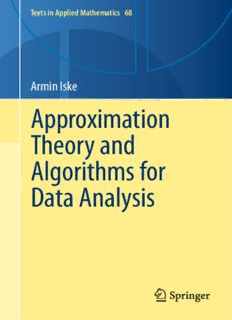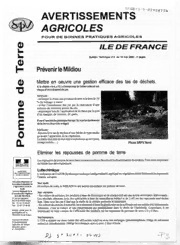
Approximation Theory and Algorithms for Data Analysis PDF
Preview Approximation Theory and Algorithms for Data Analysis
Texts in Applied Mathematics 68 Armin Iske Approximation Theory and Algorithms for Data Analysis Texts in Applied Mathematics Volume 68 Editors-in-chief S. S. Antman, University of Maryland, College Park, USA A. Bloch, University of Michigan, Public University, City of Michigan, USA A. Goriely, Universiyty of Oxford, Oxford, UK L. Greengard, New York University, New York, USA P. J. Holmes, Princeton University, Princeton, USA Series editors J. Bell, Lawrence Berkeley National Lab, Berkeley, USA R. Kohn, New York University, New York, USA P. Newton, University of Southern California, Los Angeles, USA C. Peskin, New York University, New York, USA R. Pego, Carnegie Mellon University, Pittsburgh, USA L. Ryzhik, Stanford University, Stanford, USA A. Singer, Princeton University, Princeton, USA A. Stevens, Max-Planck-Institute for Mathematics, Leipzig, Germany A. Stuart, University of Warwick, Coventry, UK T. Witelski, Duke University, Durham, USA S. Wright, University of Wisconsin, Madison, USA The mathematization of allsciences,the fading oftraditional scientificboundaries, theimpactofcomputertechnology,thegrowingimportanceofcomputermodeling and the necessity of scientific planning all create the need both in education and research for books that are introductory to and abreast of these developments. The aimofthisseriesistoprovidesuchtextbooksinappliedmathematicsforthestudent scientist. Books should be well illustrated and have clear exposition and sound pedagogy. Large number of examples and exercises at varying levels are recommended. TAM publishes textbooks suitable for advanced undergraduate and beginning graduate courses, and complements the Applied Mathematical Sciences (AMS)series,whichfocusesonadvancedtextbooksandresearch-levelmonographs. More information about this series at http://www.springer.com/series/1214 Armin Iske Approximation Theory and Algorithms for Data Analysis 123 Armin Iske Department ofMathematics University of Hamburg Hamburg,Germany ISSN 0939-2475 ISSN 2196-9949 (electronic) Textsin AppliedMathematics ISBN978-3-030-05227-0 ISBN978-3-030-05228-7 (eBook) https://doi.org/10.1007/978-3-030-05228-7 LibraryofCongressControlNumber:2018963282 MathematicsSubjectClassification(2010): 41-XX,42-XX,65-XX,94A12 Original German edition published by Springer-Verlag GmbH, Heidelberg, 2017. Title of German edition:Approximation. ©SpringerNatureSwitzerlandAG2018 Thisworkissubjecttocopyright.AllrightsarereservedbythePublisher,whetherthewholeorpart of the material is concerned, specifically the rights of translation, reprinting, reuse of illustrations, recitation, broadcasting, reproduction on microfilms or in any other physical way, and transmission orinformationstorageandretrieval,electronicadaptation,computersoftware,orbysimilarordissimilar methodologynowknownorhereafterdeveloped. The use of general descriptive names, registered names, trademarks, service marks, etc. in this publicationdoesnotimply,evenintheabsenceofaspecificstatement,thatsuchnamesareexemptfrom therelevantprotectivelawsandregulationsandthereforefreeforgeneraluse. The publisher, the authors and the editors are safe to assume that the advice and information in this book are believed to be true and accurate at the date of publication. Neither the publisher nor the authorsortheeditorsgiveawarranty,expressorimplied,withrespecttothematerialcontainedhereinor for any errors or omissions that may have been made. The publisher remains neutral with regard to jurisdictionalclaimsinpublishedmapsandinstitutionalaffiliations. ThisSpringerimprintispublishedbytheregisteredcompanySpringerNatureSwitzerlandAG Theregisteredcompanyaddressis:Gewerbestrasse11,6330Cham,Switzerland Preface This textbook offers an elementary introduction to the theory and numerics of approximation methods, combining classical topics of approximation with selected recent advances in mathematical signal processing, and adopting a constructiveapproach,inwhichthedevelopmentofnumericalalgorithmsfor data analysis plays an important role. Although the title may suggest otherwise, this textbook is not a result of the current hype on big data science. Nevertheless, both classical and contemporarytopicsofapproximationincludetheanalysisandrepresentation of functions (e.g. signals), where suitable mathematical tools (e.g. Fourier transforms) are essential for the analysis and synthesis of the data. As such, the subject of data analysis is a central topic within approximation, as we will discuss in further detail. Prerequisites.Thistextbookissuitableforundergraduatestudentswho have a sound background in linear algebra and analysis. Further relevant basicsonnumericalmethodsareprovidedinChapter2,sothatthistextbook can be used by students attending a course on numerical mathematics. For others, the material in Chapter 2 offers a welcome review of basic numerical methods.Thetextofthisworkissuitableforcourses,seminars,anddistance learning programs on approximation. Contents and Standard Topics. The central theme of approximation is the characterization and construction of best approximations in normed linear spaces. Readers are introduced to this standard topic (in Chapter 3), before approximation in Euclidean spaces (in Chapter 4) and Chebyshev ap- proximation (in Chapter 5) are addressed. These are followed by asymptotic results concerning the approximation of univariate continuous functions by algebraic and trigonometric polynomials (in Chapter 6), where the asymp- totic behaviour of Fourier partial sums is of primary importance. The core topics of Chapters 3-6 should be an essential part of any introductory course on approximation theory. V VI Preface More Advanced Topics. Chapters 7-9 discuss more advanced topics and address recent developments in modern approximation and its relevant applications. To this end, Chapter 7 explains the basic concepts of signal approximation using Fourier and wavelet methods. This is followed by a morecomprehensiveintroductiontomultivariateapproximationbymeshfree positive definite kernels in Chapter 8. The material in Sections 8.4-8.5 pro- videsmorerecentresultsconcerningrelevantaspectsofconvergence,stability, and update strategies for kernel-based approximation. Moreover, Section 8.6 presents basic facts on kernel-based learning. Lastly, Chapter 9 focuses on mathematical methods of computerized tomography, exploring this impor- tant application field from the viewpoint of approximation. In particular, new convergence results concerning the approximation of bivariate functions from Radon data are proven in Section 9.4. ForthosewhohavestudiedChapters3-6,anyofthethreemoreadvanced topicsinChapters7-9couldseamlesslybeincludedinanintroductorycourse onapproximation.Nevertheless,itisstronglyrecommendedthatreadersfirst study the Fourier basics presented in Sections 7.1-7.4, since much of the subsequent material in Chapters 8-9 relies on Fourier techniques. Exercises and Problem Solving. Active participation in exercise classesisgenerallyanessentialrequirementforthesuccessfulcompletionofa mathematics course, and a (decent) course on approximation is certainly no exception.Assuch,eachoftheChapters3-9includesaseparatesectionwith exercises. To enhance learning, readers are strongly encouraged to work on these exercises, which have different levels of complexity and difficulty. Some of the exercise problems are suitable for group work in class, while others should be assigned for homework. Although a number of the exercise prob- lems may appear difficult, they can be solved using the techniques explained in this book. Further hints and comments are available on the website www.math.uni-hamburg.de/home/iske/approx.en.html. Biographical Data. To allow readers to appreciate the historical con- text of the presented topics and their developments, we decided to provide footnotes, where we refer to those whose names are linked with the corres- ponding results, definitions, and terms. For a better overview, we have also addedaname index. The listedbiographicaldatamainlyrelies onthe online archive MacTutor History of Mathematics [55] and on the free encyclopedia Wikipedia [73], where more detailed information can be found. Preface VII Acknowledgement. The material of this book has grown over many years out the courses on approximation and mathematical signal processing that I taught at the universities of Hamburg (Germany), Lund (Sweden), and Padua (Italy). I thank the participating students for their constructive feedback, which has added great didactical value to this textbook. More- over, I would like to thank my (post)doctoral students Dr Adeleke Bankole, DrMatthiasBeckmann,DrBenediktDiederichs,andNiklasWagnerfortheir carefulproofreading.AdditionalcommentsandsuggestionsfromDrMatthias Beckmann and Dr Benedikt Diederichs concerning conceptional and didac- tical aspects as well as the technical details of the presentation are grate- fully appreciated. Last but not least, I would like to thank Dr Martin Peters (SpringerSpektrum, Heidelberg) for his support and encouragement, which led to the initiation of the book project. Hamburg, October 2018 Armin Iske iske@math.uni-hamburg.de Table of Contents 1 Introduction.............................................. 1 1.1 Preliminaries, Definitions and Notations................... 2 1.2 Basic Problems and Outlook............................. 5 1.3 Approximation Methods for Data Analysis................. 7 1.4 Hints on Classical and More Recent Literature ............. 8 2 Basic Methods and Numerical Algorithms ................ 9 2.1 Linear Least Squares Approximation...................... 10 2.2 Regularization Methods ................................. 14 2.3 Interpolation by Algebraic Polynomials.................... 19 2.4 Divided Differences and the Newton Representation......... 28 2.5 Error Estimates and Optimal Interpolation Points .......... 41 2.6 Interpolation by Trigonometric Polynomials................ 47 2.7 The Discrete Fourier Transform .......................... 51 3 Best Approximations ..................................... 61 3.1 Existence.............................................. 64 3.2 Uniqueness ............................................ 70 3.3 Dual Characterization................................... 84 3.4 Direct Characterization ................................. 87 3.5 Exercises .............................................. 99 4 Euclidean Approximation................................. 103 4.1 Construction of Best Approximations ..................... 104 4.2 Orthogonal Bases and Orthogonal Projections.............. 107 4.3 Fourier Partial Sums.................................... 110 4.4 Orthogonal Polynomials................................. 119 4.5 Exercises .............................................. 134 5 Chebyshev Approximation................................ 139 5.1 Approaches to Construct Best Approximations ............. 140 5.2 Strongly Unique Best Approximations..................... 152 5.3 Haar Spaces ........................................... 158 5.4 The Remez Algorithm .................................. 167 5.5 Exercises .............................................. 179 IX X Table of Contents 6 Asymptotic Results....................................... 185 6.1 The Weierstrass Theorem................................ 186 6.2 Complete Orthogonal Systems and Riesz Bases............. 195 6.3 Convergence of Fourier Partial Sums...................... 204 6.4 The Jackson Theorems.................................. 217 6.5 Exercises .............................................. 232 7 Basic Concepts of Signal Approximation.................. 237 7.1 The Continuous Fourier Transform ....................... 239 7.2 The Fourier Transform on L2(R) ......................... 251 7.3 The Shannon Sampling Theorem ......................... 255 7.4 The Multivariate Fourier Transform ...................... 257 7.5 The Haar Wavelet ...................................... 260 7.6 Exercises .............................................. 271 8 Kernel-based Approximation ............................. 275 8.1 Multivariate Lagrange Interpolation ...................... 276 8.2 Native Reproducing Kernel Hilbert Spaces................. 283 8.3 Optimality of the Interpolation Method ................... 289 8.4 Orthonormal Systems, Convergence, and Updates .......... 293 8.5 Stability of the Reconstruction Scheme.................... 302 8.6 Kernel-based Learning Methods .......................... 306 8.7 Exercises .............................................. 313 9 Computerized Tomography ............................... 317 9.1 The Radon Transform................................... 319 9.2 The Filtered Back Projection ............................ 325 9.3 Construction of Low-Pass Filters ......................... 329 9.4 Error Estimates and Convergence Rates ................... 335 9.5 Implementation of the Reconstruction Method ............. 338 9.6 Exercises .............................................. 345 References.................................................... 349 Subject Index ................................................ 353 Name Index .................................................. 357
Description:The list of books you might like

A Thousand Boy Kisses

Do Epic Shit

Haunting Adeline

The Spanish Love Deception

Cuentos completos

By Dr. Basheer Ahmad Mohyidin

The Princess and the Goblin

BY: / DL ABIGAIL HANGER, et al.

ERIC ED381386: Technology Learning Activities I.

The treaty of Miṣr in Ṭabari: an essay in criticism

HLA-DQ transgenic NOD models of autoimmunity

Ama-Porter

Arthur Gomes Dantas de Araújo PROVAS DE CARGA ESTÁTICA COM CARREGAMENTO ...

Two new species of the genus Gymnomus Loew from Asia (Diptera: Heleomyzidae)

1 AJANTA BULDHANA.cdr

Greek Government Gazette: Part 10, 2009 no. 544

New synonym and western range extension for Heterocloeon anoka (Daggy) (Ephemeroptera: Baetidae)

Leftopia

Avertissements Agricoles - Pomme de terre - Ile de France - 2006 - 3

Living with an Implanted Cardioverter Defibrillator (ICD)

DTIC ADA521722: Orchestrating Instruments of Power for Nationbuilding

Journal of Organometallic Chemistry 1993: Vol 448 Table of Contents


